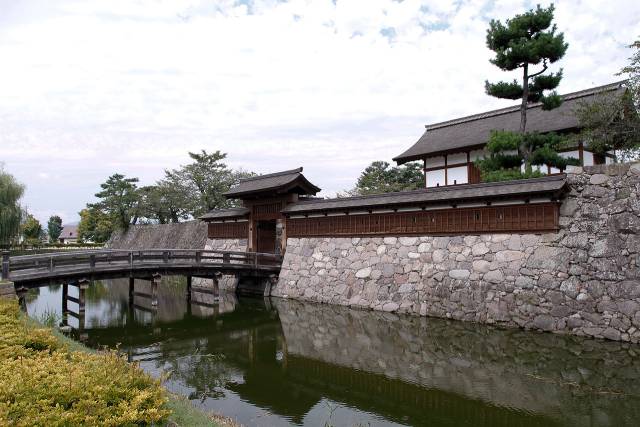
Matsushiro Castle, originally known as Kaizu Castle, is located in what was once Matsushiro town, now part of Nagano City. The site is recognized as a National Historic Site of Japan. Situated on the northern Shinano flatlands between the Chikuma River and a former riverbed that serves as a natural outer moat to the north, the castle and its surrounding town were prone to flooding due to their location.
The castle was designed in a concentric layout, with the Central Bailey (Hon-Maru) at its core, protected by walls and initially featuring a tenshu (main keep) in its northwest corner, which was later replaced by a yagura (turret). A moat surrounded the Central Bailey, which was itself encircled by the Second Bailey (Ni-no-Maru), featuring earthen ramparts and stone fortifications near its gates. The Second Bailey was bordered by a dry moat on its south and east, while the Third Bailey (San-no-Maru) lay beyond. The palace and official residences of the daimyo were located in the Hana-no-Maru enclosure, adjacent to the main defenses.
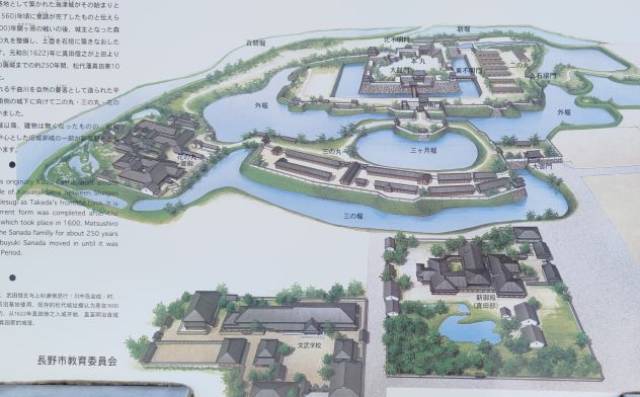
The castle’s origins date back to 1560, when it was built by Yamamoto Kansuke under the command of Takeda Shingen and named Kaizu Castle. Kosaka Danjo (Kosaka Masanobu), a retainer of the Takeda clan, was its first commander. Takeda Shingen used the castle in his battles against Uesugi Kenshin for control over northern Shinano Province. The castle is located near the site of the famed Battle of Kawanakajima, where the Takeda and Uesugi forces fought several times.
After the fall of the Takeda clan, the castle changed hands, eventually coming under Oda Nobunaga's control. However, following Nobunaga's assassination during the 1582 Honno-ji incident, Uesugi Kagekatsu reclaimed northern Shinano. The castle became a point of contention between the Uesugi and Sanada clans. Under Toyotomi Hideyoshi’s rule, the Uesugi were moved to Aizu, and after Hideyoshi’s death, the Tokugawa shogunate assigned Sanada Nobuyuki to Matsushiro Domain in 1622, relocating him from Ueda.
The castle was renamed Matsushiro Castle in 1711 by Sanada Yukimichi, the third-generation daimyo of the Sanada family. After a fire destroyed the castle in 1717, it was rebuilt the following year with the help of a 10,000 ryo donation from the Tokugawa shogunate. The castle sustained severe damage from a flood in 1742, and reconstruction continued until 1758. In 1770, the palace structures were moved to the Hana-no-Maru enclosure and rebuilt in 1804, but much of the castle was damaged again by an earthquake in 1847. Following another fire in 1853, the palace was rebuilt, and a secondary palace was constructed outside the castle in 1864.
After the Meiji Restoration and the abolition of the han system, most of the remaining structures of Matsushiro Castle were dismantled in 1871. In 1873, the remaining parts were destroyed by a fire, leaving only the stone foundations that remain today.
See also
-
Aizu-Wakamatsu Castle
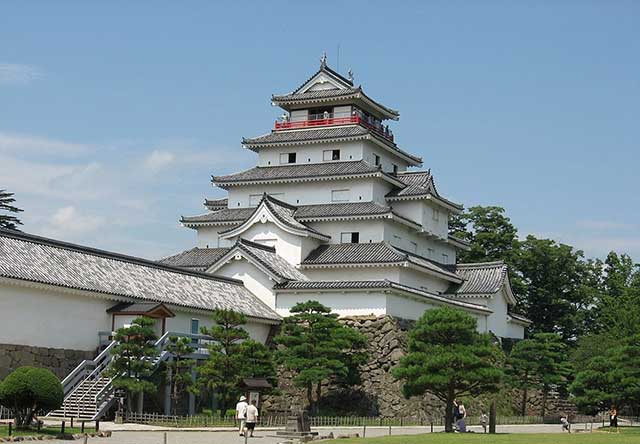
Aizu-Wakamatsu is the most powerful and at the same time the oldest castle in the Tōhoku region in the north of Honshu Island. Its history begins in the 14th century and is closely connected with the Ashina clan, whose members claimed descent from the legendary Taira family.
-
Maruoka Castle
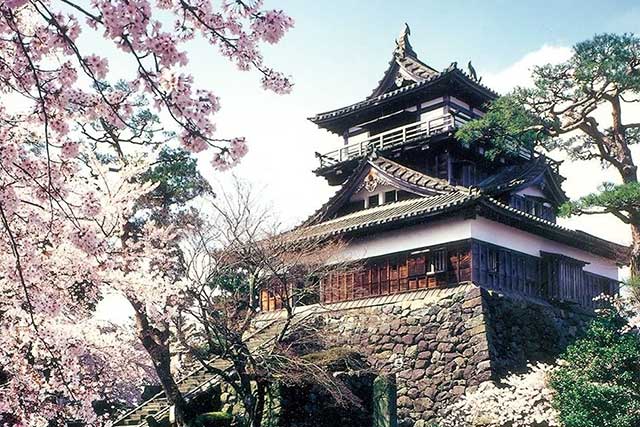
Maruoka Castle is located in the central part of the former city of Maruoka, which is now part of the city of Sakai. This area lies in the northeastern part of Fukui Prefecture. The castle was built on the bank of the Kuzuryu River, on the side opposite Fukui City, which once served as the administrative center of the former Echizen Province. Thanks to its location, Maruoka held significant strategic importance, as it controlled two major routes at once: the Hokurikudo highway leading from Kaga Province and the Mino Kaido road connecting these lands with Mino Province.
-
Marugame Castle
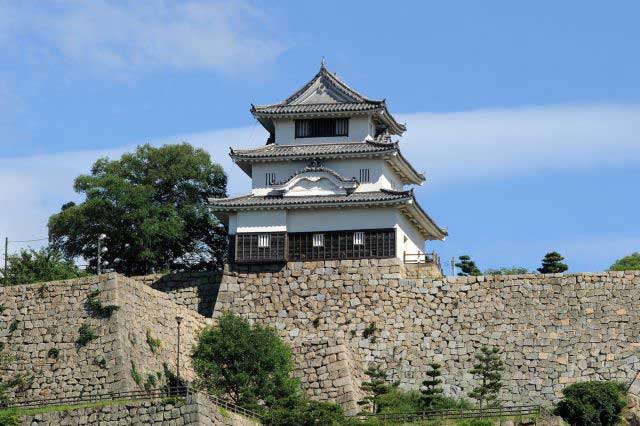
Marugame is part of the so-called “Authentic Dozen,” a group of twelve castles whose donjons have survived to the present day without major reconstructions since the Edo period.
-
Iyo Matsuyama Castle
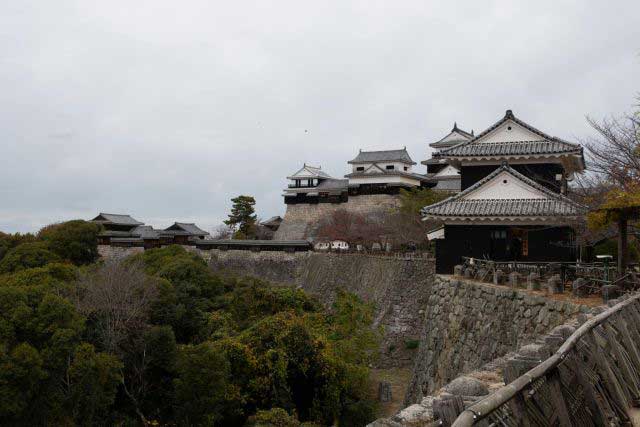
Historically, the center of Iyo Province—corresponding to today’s Ehime Prefecture on the island of Shikoku—was the city of Imabari, while the Matsuyama area was regarded as an agricultural hinterland with broad plains and low hills. During the Muromachi period, the central part of the province was governed by the Kano clan from Yuzuki Castle. With the onset of the Sengoku period, however, this clan lost its former influence and was forced to survive in the shadow of the more powerful Mori and Chōsokabe clans. After Toyotomi Hideyoshi’s forces conquered Shikoku in 1587, the northern part of Iyo Province was granted to Fukushima Masanori, one of the so-called “Seven Spears of Shizugatake.” In 1595, Masanori was transferred to Kiyosu Castle, and the lands around Matsuyama were given to another of the Seven Spears, Katō Yoshiaki, who received Masaki Castle and an income of 60,000 koku of rice.
-
Kanazawa Castle
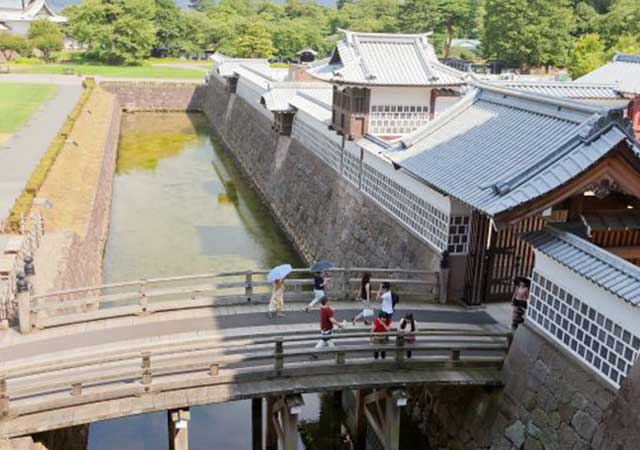
Construction of Kanazawa Castle began in 1580 on the orders of Sakuma Morimasa, a vassal of Oda Nobunaga. The castle was built on the site of the Ikko-ikki sect's Oyama Gobo temple, which is why it is sometimes called Oyama Castle. Morimasa managed to build several moats and begin construction of a castle town. However, after his defeat at the Battle of Shizugatake in 1583, he was executed, and ownership of the castle passed to Maeda Toshiie (1538–1599).
-
Nakatsu Castle
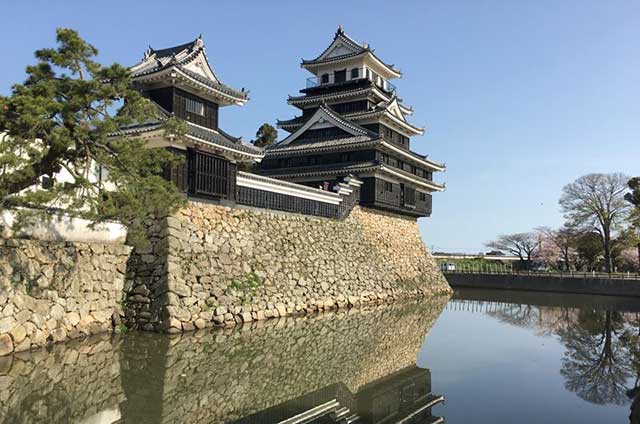
Kuroda Yoshitaka (1546–1604) was one of the closest advisors to the legendary military commander Toyotomi Hideyoshi. He took part in key military campaigns of the late 16th century, including the campaign against Shikoku in 1585 and the campaign against Kyushu in 1587. Later, during the second campaign in Korea, Yoshitaka served as chief advisor to the commander of the invasion forces, Kobayakawa Hideaki. After Hideyoshi's death, he swore allegiance to Tokugawa Ieyasu, thereby securing his influence and patronage under Japan's new leader.
-
Edo Castle
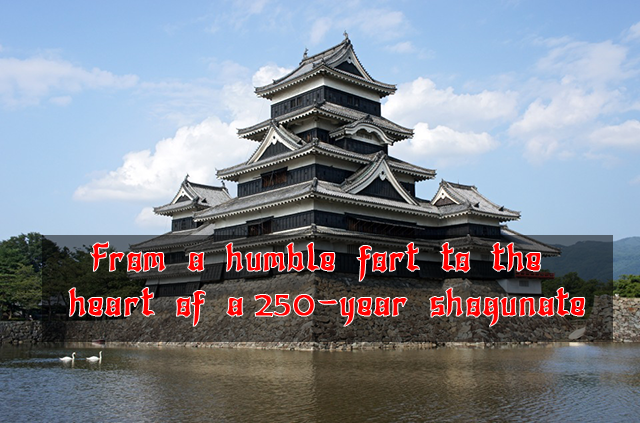
The history of Edo Castle dates back to the Heian period, when the Edo clan built a small fort on this site. In 1457, the vassal of the Uesugi clan, Ota Dokan (1432–1486), constructed a full-scale castle here. Internal conflicts weakened the Uesugi clan, and in 1524, Ota Dokan’s grandson, Ota Yasutaka, surrendered the castle without resistance to the forces of Hojo Soun, the ambitious leader of the Hojo clan. While Odawara Castle remained the clan's main stronghold, Edo was considered a key strategic fortress.
-
Samurai Museum Shinjuku
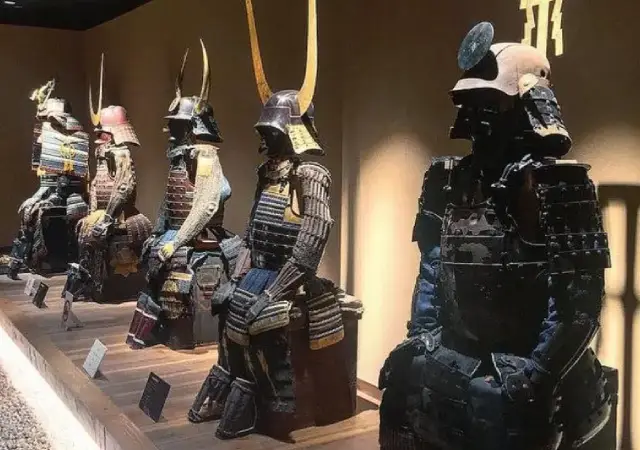
Situated in the vibrant district of Shinjuku, the museum showcases an extensive collection of samurai armor, weapons, and cultural artifacts spanning from the Kamakura to the Edo period. The exhibits aim to convey the samurai's unwavering commitment to honor and discipline, reflecting how their spirit continues to influence modern Japanese culture.

